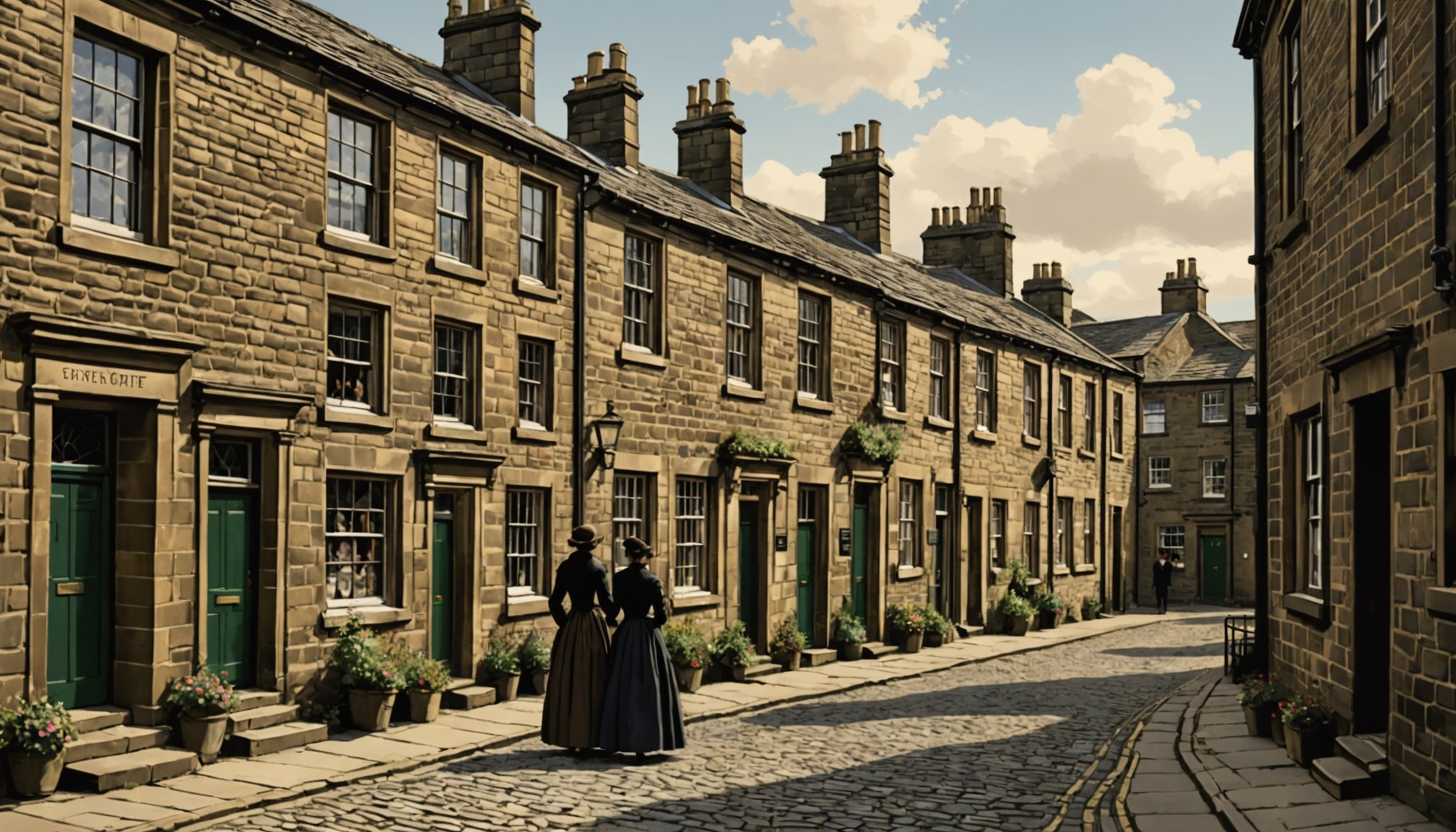Unveiling the Brontë Sisters’ Literary Legacy: A Journey Through Haworth
The Brontë Family: A Background of Tragedy and Creativity
To understand the literary legacy of the Brontë sisters, it is essential to delve into the tumultuous and creatively fertile environment in which they grew up. The Brontë family, residing in the picturesque yet harsh landscape of Haworth in Yorkshire, was marked by both tragedy and an unyielding passion for literature.
The family consisted of Patrick Brontë, the patriarch, and his wife Maria, along with their six children: Maria, Elizabeth, Charlotte, Branwell, Emily, and Anne. The early life of the Brontës was marred by the untimely deaths of Maria and Elizabeth, who succumbed to illness after a brief and miserable stint at the Clergy Daughters’ School at Cowan Bridge. This school, notorious for its poor conditions, had a lasting impact on the health and well-being of the surviving siblings, particularly Charlotte and Emily.
Also to discover : Discover unforgettable dubai desert safari tours today!
Despite these hardships, the Brontë children found solace in their imagination and creative pursuits. The sisters, along with their brother Branwell, developed a rich fantasy world, notably the kingdoms of Angria and Gondal, which served as the backdrop for many of their early writings. These fictional realms were filled with romantic outlaws, noble savages, and epic tales that would later influence their literary works.
The Literary Beginnings: Poetry and Pseudonyms
The Brontë sisters’ literary journey began with poetry, a medium that would remain dear to them throughout their lives. In May 1846, Charlotte, Emily, and Anne published a collection of poems under the pseudonyms Currer, Ellis, and Acton Bell, respectively. This volume, titled Poems by Currer, Ellis and Acton Bell, marked the first public appearance of their work and was a crucial step in their literary careers.
Also read : Experience the best dubai desert safari tours you need to try!
One of Anne Brontë’s poems from this collection, “Lines Composed In A Wood On A Windy Day,” exemplifies the sisters’ ability to capture the essence of nature and the human spirit. Written in December 1842 while Anne was a governess at Thorp Green Hall, the poem reflects her deep connection with the natural world:
“My soul is awakened, my spirit is soaring
And carried aloft on the wings of the breeze;
For above and around me the wild wind is roaring,
Arousing to rapture the earth and the seas.”
This poem, like many of their works, is a testament to the Brontës’ innate talent and their ability to find inspiration in the rugged beauty of Yorkshire.
The Novels: Timeless Classics of English Literature
The Brontë sisters are perhaps best known for their novels, each of which has become a timeless classic of English literature.
Charlotte Brontë: The Author of Jane Eyre
Charlotte Brontë’s Jane Eyre, published in 1847, is a seminal work that has captivated readers for generations. The novel, with its strong-willed protagonist and themes of love, identity, and social justice, was heavily influenced by Charlotte’s own experiences. Her time at the Clergy Daughters’ School at Cowan Bridge, for instance, is reflected in the depiction of Lowood School in the novel.
Jane Eyre remains one of the most beloved novels in English literature, and its enduring popularity is a testament to Charlotte’s skill as a storyteller and her ability to create characters that resonate deeply with readers.
Emily Brontë: The Enigmatic Author of Wuthering Heights
Emily Brontë’s Wuthering Heights, published in 1847 under the pseudonym Ellis Bell, is a masterpiece of Gothic literature. The novel, set against the backdrop of the Yorkshire moors, explores themes of love, revenge, and the complexities of human relationships. Emily’s work is characterized by its intense emotional depth and its vivid portrayal of the natural world.
Despite her reclusive nature, Emily’s novel has had a profound impact on literature, and Wuthering Heights continues to be a favorite among readers and scholars alike.
Anne Brontë: The Often Overlooked but Talented Sister
Anne Brontë, often overshadowed by her more famous sisters, was nonetheless a talented writer in her own right. Her novels, Agnes Grey and The Tenant of Wildfell Hall, offer insightful portrayals of life in the 19th century. Agnes Grey, based on Anne’s experiences as a governess, provides a poignant look at the challenges faced by women in such roles, while The Tenant of Wildfell Hall tackles themes of social morality and personal independence.
Anne’s contributions to the Brontë literary legacy are significant, and her works are increasingly being recognized for their merit.
The Brontë Parsonage: A Hub of Literary Activity
The Brontë Parsonage, located in Haworth, was the heart of the family’s literary activities. This modest house, now the Brontë Parsonage Museum, was where the sisters spent most of their lives, writing, reading, and supporting each other in their creative endeavors.
The parsonage was a place of intellectual and artistic stimulation, with the family engaging in lively discussions and debates. Patrick Brontë, a scholar and poet himself, encouraged his children’s love for literature and provided them with access to a wide range of books and educational resources.
The Influence of Byron and Other Literary Figures
The Brontë sisters were not isolated in their literary pursuits; they were influenced by various literary figures of their time. Lord Byron, in particular, had a significant impact on their work. His romantic and expressive style can be seen in the Brontës’ own writings, especially in their poetry and the heroic figures that populate their fictional worlds.
The Brontës also drew inspiration from other authors and poets, including the works of Shakespeare and the Romantic poets. This diverse range of influences helped shape their unique literary voices and styles.
Preserving the Legacy: The Brontë Parsonage Museum and Beyond
Today, the Brontë Parsonage Museum is a testament to the enduring legacy of the Brontë sisters. The museum, located in the very house where the sisters lived and wrote, offers a glimpse into their lives and works. Visitors can see original manuscripts, personal belongings, and even the dining table where the sisters would gather to discuss their writing.
In addition to the museum, various initiatives are underway to preserve the Brontë birthplace in Thornton, ensuring that future generations can continue to explore and appreciate the literary heritage of the Brontë family.
Practical Insights and Actionable Advice for Readers and Writers
For those interested in delving deeper into the world of the Brontë sisters, here are some practical insights and actionable advice:
- Visit Haworth and the Brontë Parsonage Museum: To truly understand the Brontës, visiting their home and the surrounding landscape is essential. The museum offers guided tours and exhibitions that bring their lives and works to life.
- Read Their Works: Start with their poetry collection, Poems by Currer, Ellis and Acton Bell, and then move on to their novels. Each work provides a unique perspective on the sisters’ lives and literary styles.
- Explore the Yorkshire Moors: The rugged beauty of the Yorkshire moors was a constant source of inspiration for the Brontës. Taking a walk through these landscapes can help you connect with the natural world that influenced their writing.
- Join Literary Communities: Engage with literary communities or book clubs that focus on the Brontës. Discussing their works with others can provide new insights and deepen your understanding of their literature.
Key Figures and Their Contributions
Here is a detailed list of the key figures in the Brontë family and their contributions to literature:
- Charlotte Brontë
- Jane Eyre (1847)
- Shirley (1849)
- Villette (1853)
- Pseudonym: Currer Bell
- Emily Brontë
- Wuthering Heights (1847)
- Gondal poems and stories
- Pseudonym: Ellis Bell
- Anne Brontë
- Agnes Grey (1847)
- The Tenant of Wildfell Hall (1848)
- Pseudonym: Acton Bell
- Branwell Brontë
- Contributions to the Angria and Gondal stories
- Poetry and art
- Patrick Brontë
- Encouraged his children’s love for literature
- Provided educational resources and support
A Comparative Table of the Brontë Sisters’ Novels
Here is a comparative table highlighting some of the key aspects of the Brontë sisters’ novels:
| Novel | Author | Publication Year | Main Themes | Setting |
|---|---|---|---|---|
| Jane Eyre | Charlotte Brontë | 1847 | Love, Identity, Social Justice | Thornfield Hall, Yorkshire |
| Wuthering Heights | Emily Brontë | 1847 | Love, Revenge, Family Dynamics | Wuthering Heights, Yorkshire Moors |
| Agnes Grey | Anne Brontë | 1847 | Life as a Governess, Morality | Various locations in Yorkshire |
| The Tenant of Wildfell Hall | Anne Brontë | 1848 | Social Morality, Personal Independence | Wildfell Hall, Yorkshire |
| Shirley | Charlotte Brontë | 1849 | Social Change, Love | Yorkshire |
| Villette | Charlotte Brontë | 1853 | Love, Identity, Isolation | Villette (based on Brussels) |
Quotes and Reflections
- “My soul is awakened, my spirit is soaring / And carried aloft on the wings of the breeze;” – Anne Brontë, “Lines Composed In A Wood On A Windy Day”.
- “Whatever our souls are made of, his and mine are the same.” – Emily Brontë, Wuthering Heights.
- “I am no bird; and no net ensnares me: I am a free human being with an independent will.” – Charlotte Brontë, Jane Eyre.
These quotes capture the essence of the Brontë sisters’ writing: their deep connection with nature, their intense emotional depth, and their strong sense of independence.
The Brontë sisters’ literary legacy is a testament to the power of creativity, resilience, and the enduring impact of literature on human experience. From their early days in Haworth to the global recognition they enjoy today, the Brontës have left an indelible mark on English literature. Their works continue to inspire readers and writers alike, offering a window into a bygone era while remaining remarkably relevant in our modern world. As we celebrate their lives and works, we are reminded of the timeless beauty and profound depth that literature can offer.











